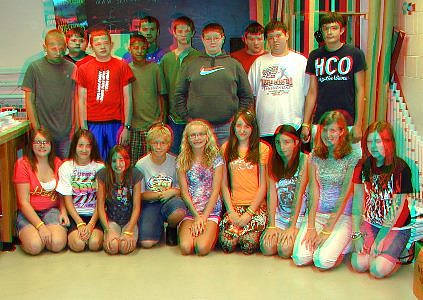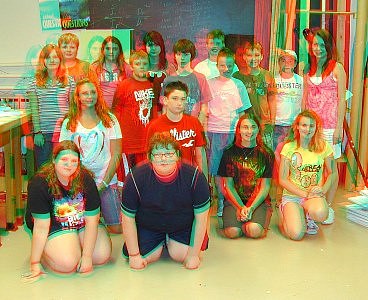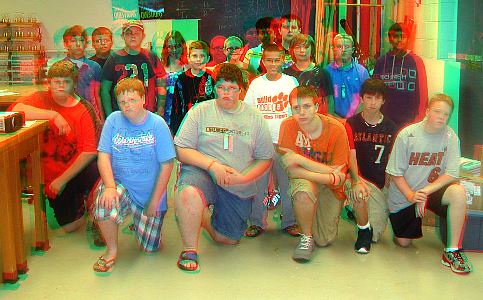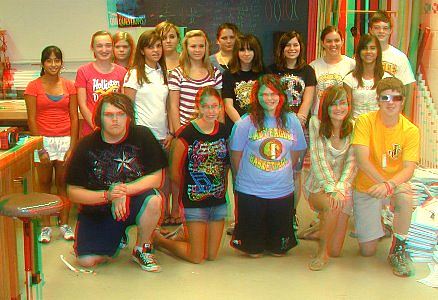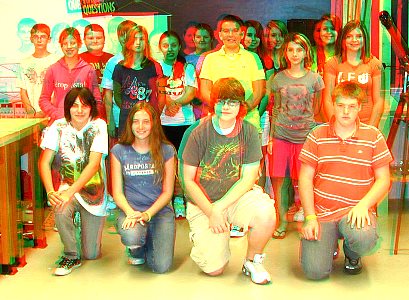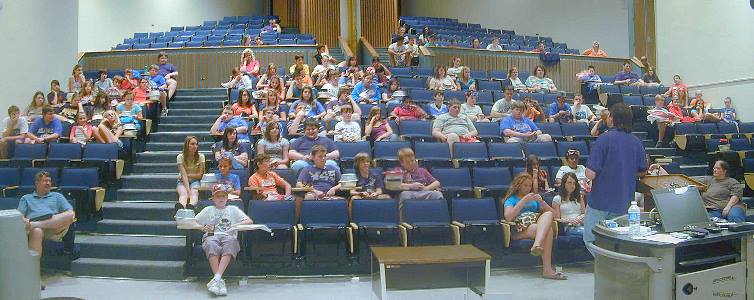Science Camp 2010 week 2
Not much here from this year yet but I am working on it.
I hope to get pictures from some of the other photographers that visited the classes so they can be included as well.
If you have some that I could use please send them to me at kuehner@usa.net
Here are the anaglyph pictures for all of the color groups.
Use your colored glasses for them.
There are also stereo pairs of each of the groups.
You can view the pairs by crossing your eyes while you look at them.
With practice, and a little luck, you will see three pictures --- the one in the center in 3D.
They may work better if you move back from your screen.
Computers
This week the task was to learn the programing language Storytelling Alice.
If you want to learn more about it you can go to the Alice web site.
I don't have any idea what is so interesting on that computer screen.
Astronomy
Campers built sundials and took a look at a timeline of the universe.
Build a telescope and chart the constellations? No problem.
Campers designed and built parachutes from tissue paper and string.
A plastic warrior was the test subject.
They tested their designs to find out which provided the slowest descent.
Physics
Here they studied parallax and how our brain uses it to allow us to judge distance.
And how we can take advantage of it to measure the distance to an object even if we can't go to it.
Across the room, a river, or even to nearby stars parallax can help us measure the distance.
They
disassembled disposable cameras to see how they work in
preparation for the construction of their own cameras later in the week.
A pair of mirrors was used to create an image of a fluffy red ball that looked real enough to pick up.
But it disappeared as you tried to grab it.
The campers lined up to see the image in the camera obscura, literally "dark room".
Polarized light is one of the ways that is used to present different images to each eye in so we can see 3D movies.
It is also used in computer monitors and cell phone displays and can reveal stress in some kinds of clear plastic.
They used a simple apparatus to demonstrate the relationship between distance and the apparent brightness of a light source.
The
brightness of a "standard candle" was compared to Christmas lights to
see how many were required to be equally bright at various distances.
The data was recorded and analyzed.
They discovered that the number of lights had to be increased by the square of the distance to get the same amount of light.
Did he learn too much or did this Fresnel lens make his head look like it its about to explode.
The
campers built cameras using two aluminum baking pans, some
black paper, tape, photo sensitive paper and what they had learned
earlier in the week.
They had to do the final assembly in near total darkness so the photo paper wouldn't be exposed.
They took them outside, held them as still as they could, and opened the shutter for 15 seconds.
Back to the darkroom to take the paper out of the camera and develop it.
I had to be sure the flash on my camera was off for these pictures.
Here are some kids with the pictures that they took with the camera they built.
The
pinhole cameras the campers built yielded a negative image so I have
inverted the colors to give you a better idea how they turned out.
Using
a round camera resulted in a number of strange orientations
although occasionally just by accident one would be correct.
Biology
Campers created bead strings that represented certain of their genetic traits.
They categorized their sex, the shapes of their chin, earlobe, thumb, and hair line
If they had dimples or freckles.
Their hair texture, the color of their eyes and hair.
Whether they were left or right handed and if they could roll their tongue.
Lots of detail to discover in models of plant and animal cells.
Campers
got to paint each of the organelles to make it easier to recognize them
when they looked at real ones through a microscope.
Campers had the chance to dissect a frog and try to find all its organs.
Some were very successful, several reported finding its tiny brain.
Lunch
At the college cafeteria.
Chemistry
Here the campers are dyeing their safety goggles custom colors.
They will use when working with chemicals and doing their dissection later in the week.
A couple of the helpers seem to have gotten "damp" from head to toe preparing for the contests on Thursday.
At the end of each day campers were given information about the next days' activities.
Thursday
they tried a couple of game show like contests "Minute to win it" and
"a science version of "Who wants to be a millionaire".
They designed
and constructed bridges, boats, airplanes, and towers to specification
with limited construction materials and time.
And tried to hit a target with a water balloon propelled by a 3 kid slingshot and several other challenges.
If they had time they also got to try an old time toy that demonstrates a lot of physics or do math related puzzles and games.
The big contest, with big prizes, was to build a wind turbine that we tested to find the ones with the best performance.
Some of the designs and desighers waiting for the testing to begin.
And the winners are---
Go to our Science Fun
page
Go to our Travels page
Go to our Personal home
page
Go to our Community page
E-mail Nancy and Alan

The
www.mrtc.com/anvk/ web site by Alan
Kuehner is licensed under a Creative
Commons License.
Additional information and permissions beyond the scope of this license are available here.
